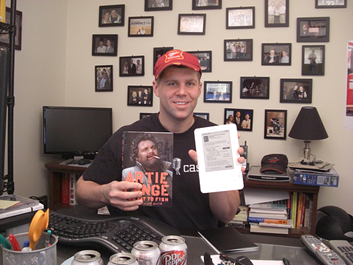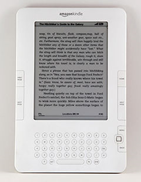Reason #999,667,322 to show healthy skepticism toward the mainstream media:
 “On Monday, the Kindle 2 will become the first e-reader available globally. The only other events as important to the history of the book are the birth of print and the shift from the scroll to bound pages. The e-reader, now widely available, will likely change our thinking and our being as profoundly as the two previous pre-digital manifestations of text.”
“On Monday, the Kindle 2 will become the first e-reader available globally. The only other events as important to the history of the book are the birth of print and the shift from the scroll to bound pages. The e-reader, now widely available, will likely change our thinking and our being as profoundly as the two previous pre-digital manifestations of text.”
So writes Esquire’s pop critic, Stephen Marche, in the Wall Street Journal. This isn’t satire, but rather his serious opinion.
In real life, Kindle owners like Affiliate, seen in the Creative Commons photo above, would probably express enthusiasm but show far more commonsense and restraint. Here’s my own take on the Kindle 2. It comes away a number of negatives: onerous Digital Rights Management, focus on a proprietary format, high price, less than perfect contrast between text and the screen background. I myself took great pleasure in knocking the original Kindle (right photo below) for its adding-machine looks and ergonomic challenges such as hair-trigger page controls. What’s more, Amazon needs to treat writers and publishers better—much better.

 That said, I’m pleased to give the Kindle 2 (left) its due. The positives:
That said, I’m pleased to give the Kindle 2 (left) its due. The positives:
1. The hair-trigger problem is gone and page turning controls are mostly just where I’d want them—in fact, better positioned than those on various Sony Reader models. While my fingers are over the controls, I feel as if the 10-ounce weight is distributed well. I like the controls off to the side rather than on the the bottom (or present in the form of minuscule buttons). One improvement for me would be to put both the previous-page and next-page controls on the same side.
2. A simple unofficial font hack for the Kindle 2 can now helps with the contrast problem by making the characters bolder. Hacks exist for the Sony Reader—I haven’t tried them. But the Kindle hack seems the easiest.
3. The text-to-speech capability is great for walking or other forms of exercise, or in the future for long drives. Shame on Amazon for knuckling under to misguided publishers, when TTS is one of the 2’s best features. This feature will boost e-book sales to the point where the increased revenue will more than compensate for lost audio book sales.
4. Amazon’s prices and book selections could be better—but remain competitive. This may not be true in the future if the company keeps walling itself off from the ePub world. More and more publishers will focus on the ePub format if current trends hold up. Jeff Bezos has hinted the the company might do ePub; time for a little action.
5. I love the dictionary, even though it would be wonderful if I could simply use a stylus to point at the appropriate word.
6. My most-often used reader remains my iPod Touch, but at least now I can use the K2’s synching feature to keep my place in a book while going back and fourth between machines. WhisperSynch isn’t perfect, sometimes it loses track of where I am, but it is a good start. Believe me, the IDPF or someone else needs to come up with an inter-device page-synching standard that would work across a number of brands. It should even coordinate text and audio books (yes, real audio books, as opposed to those created in effect by text to speech).
As for the aesthetics, the adding machine look is gone, though it would be nice for the case to be darker, which, as others have noted, would improve the perceived contrast.
Hey, I call ‘em as I see ‘em. I can’t wait to see what Amazon does with future Kindles—starting, I’d hope, with the inclusion of ePub.
(Gushy WSJ article via Kindle Review.)

































This demonstrates how out-of-touch Marche is… Kindle is hardly the first globally-available reader. But then again, Esquire was the mag that thought slapping an eInk sheet on a printed magazine was the “future of publishing.” And his “transbook” name is the sort of thing a self-styled “pop culture writer” would come up with, i.e., pretty empty of meaning and missing the point of e-book readers… not to mention thinking the industry needs a slick name for the readers at all.
I would actually disagree with Steve J. I dislike Esquire, and as disingenuous as it may be with hyperbole such as Marche’s, I think the Hearst corporation knows exactly what they’re doing.
As techies, we may today roll our eyes at Esquire’s E-Ink issue as a dated meaningless gimmick. More sensationalizing techno-utopian misinformation like much of the hype journalism that pollutes the tech world (a la Wired and Scientific American).
But given its time and audience, the Esquire issue was seen by e-ink followers as a means of kick-starting a (at teh time) quiet industry through mainstream enthusiasm. In its context, the Esquire issue introduced e-ink in a friendly, if ostentatious, way to the very consuming class that would make the production of readers fiscally possible.
Esquire, like Wired, is among legions of magazines whose success rides on declaring, and being trusted as a source for, the new hip product, perfume, or look. Esquire was hedging its bets and some of its money on e-books and e-delivery of magazines when it said to its readers upfront “you should too!” I’m glad they did.
The publication of the e-ink issue had nothing to do with making cogent arguments about e-ink or functional publishing models. They’re tricky like that.
Yes… that’s why Esquire is so often quoted and singled out as being on the forefront of the modern age… as opposed to the rich old fogeys trying to figure out what the grand-kids are doing in the basement, and whether or not there might be something to this whole “interwebs” thing…